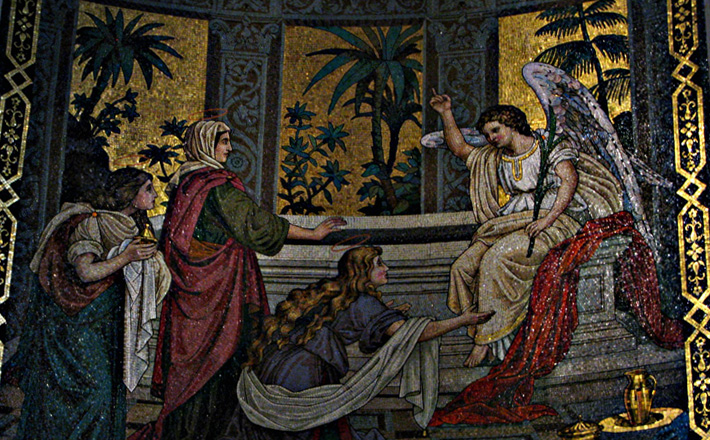Commentary on Acts 10:34-43
The lectionary passage Acts 10:34-43 features the sermon that Simon Peter gave in the house of Cornelius, a Roman centurion, in the city of Caesarea Maritima.
The broader context is important to understand Peter’s homily but lacking from the lectionary passage; therefore, I will summarize it here and present the main characters before addressing the actual message of the sermon.
Luke narrates that the Jews who believed in Jesus were being persecuted and had to flee from Jerusalem (Acts 8:1). In the course of these events, Simon Peter traveled west to the city of Lydda, where he healed a paralyzed man, and then to Joppa on the Mediterranean coast, where he restored the female disciple Tabitha (Dorcas) to life (9:32–43).
The next events all happen along this coastline. Further north is Caesarea (Maritima), a city that Emperor Augustus had given to Herod the Great in 30 B.C. and that became the capital of Palestine when Rome took control in 6 C.E. Caesarea featured an impressive artificial harbor and was the seat of the major Roman garrison. This means the city was the epitome of Roman presence and administrative control. It is thus fitting that, when Luke mentions Caesarea in Acts 10:1, the first person he introduces is a Roman centurion named Cornelius.
That person could be portrayed as a ruthless official executive. Luke, however, surprises his readers. He describes Cornelius as “a devout man who feared God with all his household; he gave alms generously to the people and prayed constantly to God” (Acts 10:2). He is thus sympathetic to Judaism. According to Luke, he does not belong to the group called “proselytes,” who were Gentiles observing all the Old Testament laws; instead, Cornelius is a “God-fearer” who respected and acknowledged the Old Testament moral teaching. His piety is further manifest in a vision from God in which he is asked to have Simon Peter come from Joppa.
By coincidence, Peter too is having a vision; he sees an “object” (Greek skeuos) resembling a big sheet that is being lowered down from heaven. It contains various kinds of animals that, according to the purity laws of the Torah, are considered unclean and, therefore, prohibited for consumption (Leviticus 11). In the vision, however, a heavenly voice tells Peter to “kill and eat” the animals (Acts 10:13). As a devout and Torah-observing Jew, Peter is reluctant to follow such advice, yet the heavenly voice insists three times: “What God has made clean, you must not call profane” (10:15).
Puzzled about his vision, Peter agrees to travel to Caesarea, some fifty kilometers away. On the way, it dawns on him that the vision might refer to the encounter between Jews and Gentiles: He must first visit Cornelius, the Roman centurion; only then can he proclaim the good news about Jesus Christ.
Yet will he not be in danger? What will his arrival in Caesarea, the Roman capital of Palestine, yield? What about his encounter with the non-Jew, the “other”? Luke surprises his readers once more. Cornelius, the centurion used to others obeying his orders and honoring him, falls down before Peter to worship him. The first things the apostle does at the house of Cornelius points forward to the sermon he soon delivers: He literally “raises up” his host and tells him: “Stand up!” (Acts 10:26) These are the key words of the gospel about the resurrection of Jesus (10:40, 41).
Thus, Peter gives his last great missionary speech in the book of Acts. It is structured as follows:
10:34–36, Introduction: The impartial God has sent Jesus as Lord of all.
10:37–41, Kerygma: Life, death, and resurrection of Jesus.
10:42–43, Conclusion: We are his witnesses and announce forgiveness of sins in his name.1
I want to focus on the middle section of this missionary sermon. It presents an outline of the story of Jesus, beginning with his baptism by John. The next sentence interprets this event in a typical Lukan fashion: “God anointed Jesus of Nazareth with the Holy Spirit and with power” (10:38). Luke is indeed the theologian of the Holy Spirit. He mentions, for example, “instructions through the Holy Spirit to the apostles” (Acts 1:2), the arrival of the Holy Spirit at Pentecost (2:1–13), and how the Holy Spirit falls upon all who listen to Peter’s sermon (10:44–45). Thus, the Roman centurion eventually becomes the first gentile Christian.
In his sermon, Peter goes on to mention how Jesus was “doing good and healing all who were under the power of the devil” (10:38) and how he was then crucified and raised from the dead “on the third day” (verse 40). This expression belongs to the earliest proclamation about Jesus (see also 1 Corinthians 15:4). Two remarks are important regarding this topic. First, Christians should exercise care not to think that resurrection is characteristic of Christianity and would distinguish it from Judaism. Resurrection is, instead, a religious concept promulgated by the Pharisees, a Jewish subgroup.
Second, resurrection is not resuscitation. Both are miraculous but different. Peter was able to resuscitate Tabitha (Acts 9:36–43), yet she remained a mortal human being. The resurrection of Jesus is of a different quality. The risen Jesus belongs to the heavenly realm and has an eternal body. This post-mortem body is, nevertheless, of a corporeal nature; Jesus did not become a ghost. Peter therefore mentions that Jesus ate after his resurrection (10:41; see also Luke 24:30).
Both resuscitation and resurrection, however, demonstrate alike that in God’s eschatological kingdom, death as the “hostile, cosmic power”2 will be vanquished and life will reign. God will reign over the entire earth. In this eschatological kingdom, also the division between Jew and Gentile, slave and free, or male and female will be overcome.
In the words of Jeromey Martini: “Resurrection … becomes not simply a believer’s personal privilege, but a passive part of Christ’s grander cosmic activity: a constituent part of God’s ‘all in all’ order.”3 A facet of God’s all encompassing reign is foreshadowed when the division between Jew and Gentile has been overcome in the encounter between Simon Peter and the Roman centurion Cornelius.
Notes:
1 According to Fitzmyer, Joseph A., S.J., The Acts of the Apostles: A New Translation with Introduction and Commentary (Anchor Bible 31), New York: Doubleday, 1974, p. 460.
2 Martini, Jeromey, “An Examination of Paul’s Apocalyptic Narrative in First Corinthians 15:20–28,” in: Criswell Theological Review 8 (2011, pp. 57–70), p. 64.
3 Ibid, p. 69.


April 20, 2014